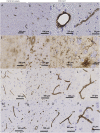Neurologic phenotypes associated with COL4A1/ 2 mutations: Expanding the spectrum of disease
- PMID: 30413629
- PMCID: PMC6282239
- DOI: 10.1212/WNL.0000000000006567
Neurologic phenotypes associated with COL4A1/ 2 mutations: Expanding the spectrum of disease
Erratum in
-
Neurologic phenotypes associated with COL4A1/2 mutations: Expanding the spectrum of disease.Neurology. 2020 Feb 18;94(7):332. doi: 10.1212/WNL.0000000000008787. Epub 2020 Jan 24. Neurology. 2020. PMID: 31980581 Free PMC article. No abstract available.
Abstract
Objective: To characterize the neurologic phenotypes associated with COL4A1/2 mutations and to seek genotype-phenotype correlation.
Methods: We analyzed clinical, EEG, and neuroimaging data of 44 new and 55 previously reported patients with COL4A1/COL4A2 mutations.
Results: Childhood-onset focal seizures, frequently complicated by status epilepticus and resistance to antiepileptic drugs, was the most common phenotype. EEG typically showed focal epileptiform discharges in the context of other abnormalities, including generalized sharp waves or slowing. In 46.4% of new patients with focal seizures, porencephalic cysts on brain MRI colocalized with the area of the focal epileptiform discharges. In patients with porencephalic cysts, brain MRI frequently also showed extensive white matter abnormalities, consistent with the finding of diffuse cerebral disturbance on EEG. Notably, we also identified a subgroup of patients with epilepsy as their main clinical feature, in which brain MRI showed nonspecific findings, in particular periventricular leukoencephalopathy and ventricular asymmetry. Analysis of 15 pedigrees suggested a worsening of the severity of clinical phenotype in succeeding generations, particularly when maternally inherited. Mutations associated with epilepsy were spread across COL4A1 and a clear genotype-phenotype correlation did not emerge.
Conclusion: COL4A1/COL4A2 mutations typically cause a severe neurologic condition and a broader spectrum of milder phenotypes, in which epilepsy is the predominant feature. Early identification of patients carrying COL4A1/COL4A2 mutations may have important clinical consequences, while for research efforts, omission from large-scale epilepsy sequencing studies of individuals with abnormalities on brain MRI may generate misleading estimates of the genetic contribution to the epilepsies overall.
Copyright © 2018 The Author(s). Published by Wolters Kluwer Health, Inc. on behalf of the American Academy of Neurology.
Figures




References
-
- Gould DB, Phalan FC, Breedveld GJ, et al. . Mutations in COL4A1 cause perinatal cerebral hemorrhage and porencephaly. Science 2005;308:1167–1171. - PubMed
-
- Gould DB, Phalan FC, van Mil SE, et al. . Role of Col4a1 in small-vessel disease and hemorrhagic stroke. N Engl J Med 2006;354:1489–1496. - PubMed
-
- Vahedi K, Alamowitch S. Clinical spectrum of type IV collagen (COL4A1) mutations: a novel genetic multisystem disease. Curr Opin Neurol 2011;24:63–68. - PubMed
Publication types
MeSH terms
Substances
LinkOut - more resources
Full Text Sources
Other Literature Sources
Medical
Molecular Biology Databases
